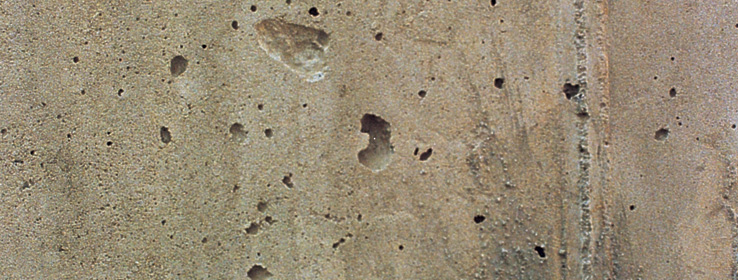Cost-effective, sturdy, versatile – it's no wonder use of concrete in commercial and residential construction is increasing.
One reason for the continued increase in concrete use is that architects and developers are discovering that this reliable old stand-by is ideal for far more than walls and floors. With the right mix of skill and knowledge, concrete can be intricately textured, colored and patterned for a multitude of strikingly beautiful uses, from gracious lobbies, pool surrounds and patios to handsome pillars, columns and even countertops.
Like a hand-in-glove, concrete and coatings belong together. Whether the function of the concrete coating is decorative or protective – or a combination of both – coatings and decorative finishes can enhance concrete surfaces in ways that impart style, improve longevity and increase client satisfaction with the project - along the way transforming a dull, colorless expanse into a noteworthy design element.
Dispelling the Myths
Smart contractors, with the help of an ever-growing selection of concrete finishing products, are taking advantage of this increased awareness of concrete's aesthetic possibilities. As a result, they are expanding their markets by learning the methods and techniques to deliver these exciting new looks. But what exactly do contractors need to know about concrete coatings?
With all of the new products and techniques available to help contractors achieved desired effects, some confusion about coating characteristics and attributes is inevitable.
Myth #1 : All the various products and processes available today to colorize and detail concrete are "coatings."
From acid-etch stains and color admixtures to concrete etching and overlays, there are numerous ways to enhance the appearance of concrete surfaces. But many of these are not actually concrete "coatings." Acid, polymer and other chemical stains, for example, are not paints or coatings, but are, rather a coloring process that initiates a chemical reaction with a cementitious surface.
Water-based concrete stains, typically composed of acrylic resins – while technically not coatings – behave more like coating products because they do not react chemically with cementitious materials. Instead, these products penetrate deeply into the concrete surface, providing colorization and protection against harmful elements to both vertical and horizontal surfaces.
Water-based acrylics resist fading and abrasion, and they may be applied using stencil designs to create faux brick and geometric effects. Easier to apply than chemically reactive stains, water-based acrylics clean up with soap and water. Another advantage is compliance with even the strictest air quality regulations due to their very low VOC (volatile organic compound) content.
Myth # 2: Coatings, by their nature, bridge the porous surface of concrete, trapping moisture already present that seeks to escape through the surface and setting the coating up for failure.
Not necessarily. Coatings do bridge porous surfaces, in the process protecting concrete and masonry surfaces from water penetration. But a number of newer concrete coatings are available that are highly permeable from the substrate side. There are new elastomeric coatings, for example, that are as easy to apply as paint, but which allow moisture vapor from within the concrete to escape. This quality virtually eliminates the problems of blistering, peeling and delamination associated with most concrete coating failures.
Elastomeric concrete coatings apply to a thick, elastic film that enhances concrete surfaces by providing uniformity while concealing hairline cracks, patches and other irregularities. At the same time, these coatings improve concrete longevity by providing protection from wind-driven rain, even in coastal or severe-weather environments. They are available in a wide range of colors and also may be tintable.
Textured elastomeric coatings provide these same benefits, while offering the advantage of an imperfection-camouflaging, uniform finish that adds visual interest to otherwise ordinary pre-cast panels or concrete block surfaces. Such coatings are available in different textures, plus a wide variety of factory-tint or store-tint custom colors, so enhancement possibilities are numerous. What's more, the choice of textures makes it possible to easily match new areas to existing textured surfaces to deliver a clean, consistent look across an exterior expanse.
Myth #3: Concrete must cure for at least 30 days before coating.
While many coating products cannot be applied to "hot" masonry surfaces (NOTE: always carefully read and follow the individual manufacturer's instructions) some primers and topcoats can be used after just seven days of curing. These systems may provide an ideal solution to schedule conflicts resulting from weather or other job-related delays, or help make possible a fast-track construction schedule.
Look for primers and topcoats that can be used successfully on substrates with surface pH levels from 6-13. These systems are available in white as well as a wide range of pastel and deep-base shades.
Myth #4: Concrete block fillers are unnecessary, heavy and difficult to apply.
What better way to prepare a rough, uneven profile for a beautiful topcoat or decorative finish than using concrete block surfacer? These coatings dramatically enhance a concrete surface by providing a stable, uniform foundation for finishing by filling pores, voids and pinholes – often in just one pass. But unlike the block fillers of old, new, lightweight concrete block surfacers are available today that backroll faster and with less effort, so they save on application time. These products may weigh as much as 30 percent less than traditional block fillers. They are also useful for building a solid barrier between topcoats and the substrate, preventing pH burns even over freshly cured mortar.
Myth # 5: Chalky concrete cannot be coated.
While chalking concrete should not be directly topcoated, it certainly can be prepared for topcoating through the use of concrete conditioner products. These coatings penetrate deeply into masonry substrates to secure chalky surfaces and create a stable base for long lasting finish coats. On new construction, they may be used as a penetrating sealer for surfaces that include 7-day- cured concrete. An added advantage of concrete conditioner use is prevention of topcoat delamination and alkali burn – even on concrete substrates with pH levels as high as 13. These coatings can serve as an economical alternative to primers and are particularly useful on rehab projects where the existing topcoat has deteriorated over time.
A Word About Surface Preparation
While conditioners can go a long way toward preparing a concrete surface for topcoating, before any coating is applied, some simple steps should be taken to assure a proper bond. Most coating failures occur not because of improper coating application, but because of inadequate surface preparation. For a coating to properly adhere to a concrete surface, the surface must be clean, dry, dull, sound, and free of surface defects such as cracks or spalling. These areas should be repaired using the appropriate patching compounds. The surface to be coated should have a slightly rough profile – approximately equivalent to a piece of 120-grit sandpaper.
Be sure to clean the concrete to remove any grease, oil, dirt, old paint or other contaminants, using one of the methods recommended by the manufacturer of the coatings you will be using for the job. It's important that the surface is properly prepared so that it is compatible with and receptive to the specific coatings you plan to apply, so be sure to check your tech data pages. Pebble blasting, power washing, acid etching or cleaning with a commercial concrete cleaning agent are among the methods that may be recommended.
Before coating, a concrete surface should be:
Clean
Dull
Dry
Sound
Free of surface defects
Learn more about Sherwin-Williams Concrete and Masonry Products









